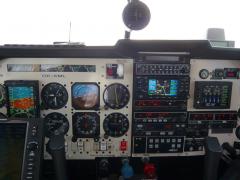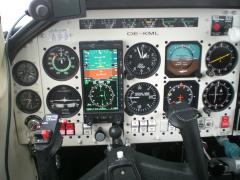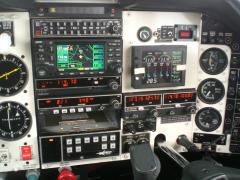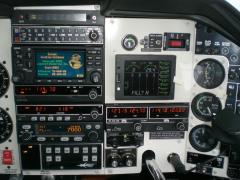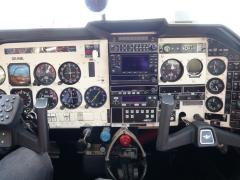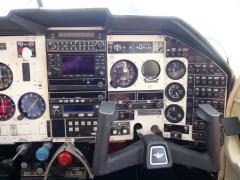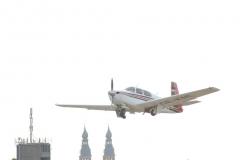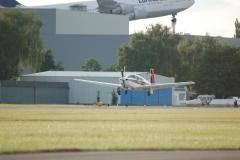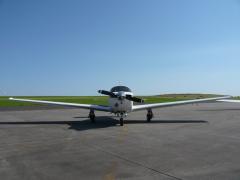-
Posts
432 -
Joined
-
Last visited
Content Type
Profiles
Forums
Blogs
Gallery
Downloads
Media Demo
Events
Everything posted by Magnum
-
Looks really good, esp. the flush mounting.
-
My 2 cents for Garmin versus Aspen reliability. Since I installed the Aspen I realize how often my Garmin 430W fails, as it announces "GPS failure" in front of my nose. Looses satellites every 2-3 hours for a couple of seconds. Usually not a very big deal, as it reaquires within 10-20 seconds, but no joy if you fly a GPS approach to minimums (at least for me, my IR is still wet). My avionics shop told me that Garmin had a whole batch of defective antennas, if it fails it even blocks the reception of another GPS. The Aspen had no problems so far. So it is not always black and white, more like shades of gray.
-
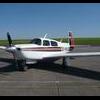
Whelen: Super-LED Landing & Taxi Light now STC App
Magnum replied to Hank's topic in General Mooney Talk
The Parmetheus PAR 46 LED has now PMA (no STC necessary, can be installed in foreign registered aircraft, too) -
Let's keep it simple: With the same FF we are faster than brand B, P or C.
-
From the album: #Magnum's album
-
Quote: Jeff_S Two more issues to consider. In colder weather, the air is denser as you note in your post, so there are more air molecules for the prop to chew through. This is effectively what Ross was joking about when he said you'd have to stop for traffic lights...the only way to get 100% HP out of a normally aspirated engine is at sea level. So yes, in colder air you will get a greater TAS for a given altitude than you would in warmer air, all else being equal.
-
IMHO 201er is right. To get apples to apples comparison you need %HP, DA and mixture setting. If it makes sense to throttle back for a normal cruise is different question. My Mooney is faster in the summer with the same %HP due to a higher DA (and needs more MP to achieve the same power) I get 160kts at 65%HP, 50dF ROP, DA 7500ft, 150lbs below MGW, 10 GPH (the FF in the picture reads 3-4% high) Edit: Added readable cutouts of the picture...
-
Quote: OR75 Anyone knows wht the tube in the attached picture is for ? looks like a vent.
-
Quote: Hank My light shows some of the ground when taxiing, but illuminates the hangars all the way to the roof. On final, though, with T/O or more flaps, it seems to shine right on the numbers or just past. Seems like there is some alignment on the bulb--but you have to drop the lower cowl to reach it. Haven't changed mine in a while, though, so my memory isn't the best. Check your maintenance manual to confirm.
-
Quote: alex currently 2.6 euro/liter in Belgium to have it $ that is 3.5 $/liter..or about 11$/gallon..no fun!
-
Quote: Wistarmo To Magnum: Forgive me if I misunderstand your question, but I am unable to find a "maximum performance landing" in my POH. If you could direct me, I would be interested in finding that table. My POH only has tables for "Normal Landing" on "Hard Surface" and "Normal Landing" on "Grass Surface". That is all that I am trying to do, a normal landing.
-

Traffic Alerting Experience?
Magnum replied to FullyArticulate's topic in Miscellaneous Aviation Talk
Quote: Piloto Flieger Magazine of Germany http://www.fliegermagazin.de/aktuelles_heft/aktuelles_heft/index.php has an interesting article this month comparing Monroy, Zaon and European made devices. I don't know if they have an English version of the article but the pictures looks pretty good. Of course anything european is better. José -
With the original starter (cold engine) between 2 and 4 seconds depending on OAT, but I keep the mixture full rich. With the skytec I need 1-2 seconds longer. Timing starts when the fuel pressure goes up. Hot start (up to 30 minutes since shut down): Don't touch anything, just crank. If it stood longer, 1-2 seconds then mixture cut off and start. The skytec really helps with a hot engine.
-
Quote: Wistarmo According to my POH, Section V, "Normal Landing Distance", the recommended approach speeds are 70 kts at 2300 lbs, 74 kts at 2600 lbs, and 78 kts at 2900 lbs, with full flaps. I am not working out of short fields, however, and in hot and humid Florida I usually avoid fields less than 3000 feet. Rather than try and specify for others an exact speed for their approaches and landings, I think what I would like to communicate is that one speed doesn't fit all weights and each pilot should see what works for their aircraft under a variety of loading conditions. For me and my plane, coming in solo at 70 kts leads to floating down the runway, and coming in with three passengers at 70 kts leads to a teeth-jarring landing.
-
Quote: allsmiles I do have one question however if someone cares to entertain. Do you guys fly an approach with ap in NAV mode or HDG? I have the KFC150 and GTN750. I know in vectors to final we fly HDG but I'm referring to self flying the approach to a transition outside the FAF without being vectored. Do you fly in NAV or HDG mode?? And if the answer is NAV mode I have another specific question to follow!! Thanks!! HAPPY FOURTH TO ALL!!!
-
Quote: 201er Is this typical on all Mooneys or do I need this checked out. On Pipers I've previously flown, the response time of pulling the prop knob back during runup felt quick but on my 201, I have to pull and hold it back a few seconds until the RPM drops. It seems to be the same case in flight which has been causing me to pull back too far because at first it wasn't doing anything and then jump too far. I'm getting used to this and the prop control seems to function normally other than the brief delay. So is it normal to have the prop knob back a few seconds while cycling the prop on runup?
-
I'd use AMP connectors. Not cheap, but they last forever. You'll have to order the pins seperately, but you don't need the crimping tool. Universal pliers should work.
-
Get a EDM 800 or 830, it will calculate it for you (including mixture setting, you'll see how much power you have left when LOP). If you have an Iphone you can use the app IO360. The calculations are based on the Lycoming operators manual, so they might differ a bit to the POH. IMHO values are better than from the POH as no marketing department influenced them.
-
Correction: It should be max. 2% difference in power, and mabe max. 2 KTAS difference.
-
Best power will produce more power than economy. Between 100 ROP and 25 ROP (the recommendation in the POH) the difference should be around 3-4% (see attached picture). IMHO you'll see approx. 3-4 KTAS between Best power and best economy.
-
I talked to my avionics shop today to get my Aspen updated to V2.x (from 1.x). They told me that the update fails at approx. 10% of the units. It has to be sent to Aspen, and they fix it at no charge. Problem is, my shop doesn't have a spare, so the Mooney would be grounded until it is back. Does someone have experience with (failed) updates? I only want to hear from people who had no problems at all so I will go for it :-)
-
I am in. Even if we have to raise more money to pay someone for the transfer / support. But Craig has to say what he wants, he is the founder of this great site. Even with the bugs it is still better than the alternatives. I hate browsing through mailing lists...
-

Poor Engine Power (RPM) Problems - M20J
Magnum replied to bennergh's topic in Modern Mooney Discussion
I don't think it is the engine. IMHO you need approx. 60-70% HP to get 2200-2400 RPM static, if the prop is in fine pitch. I doubt that the engine is producing so little power, as it would be hard to get your mooney off the ground. If your prop is not in fine pitch, you won't have full power available and you are at the limit for max. manifold pressure for continous operation: At 2200 RPM Lycoming limits man. pressure to 27", at 2400 RPM it is 28". The engine has to work very hard, temperatures go up and detonation is more lilely. Think about driving your car with low RPM in high gear and full throttle. I am not a prop expert, but suggest to check the blade angle in fine pitch first and then make sure that no oil pressure is getting to the prop to keep it on fine pitch (I think a plate can be installed instead of the prop governor for the job). Run the engine and check if you get max RPM (but be careful to not go over 2700). -
+1 IMHO it is easier for the eyes to focus on the instruments with the lighter panel.




